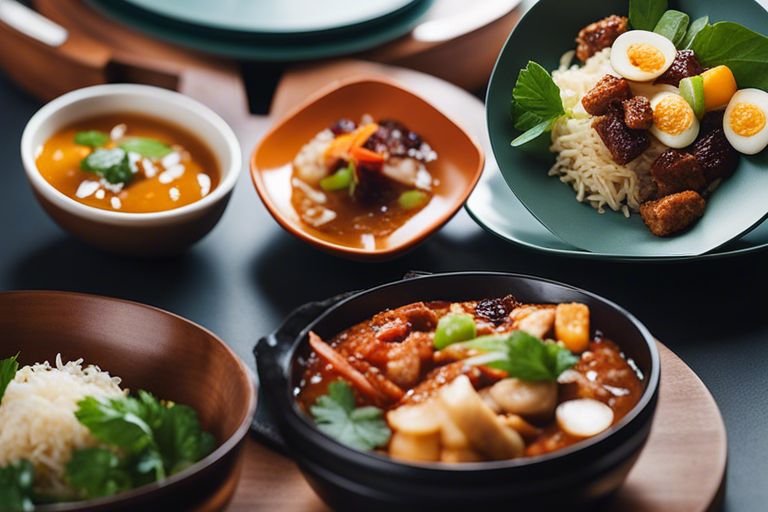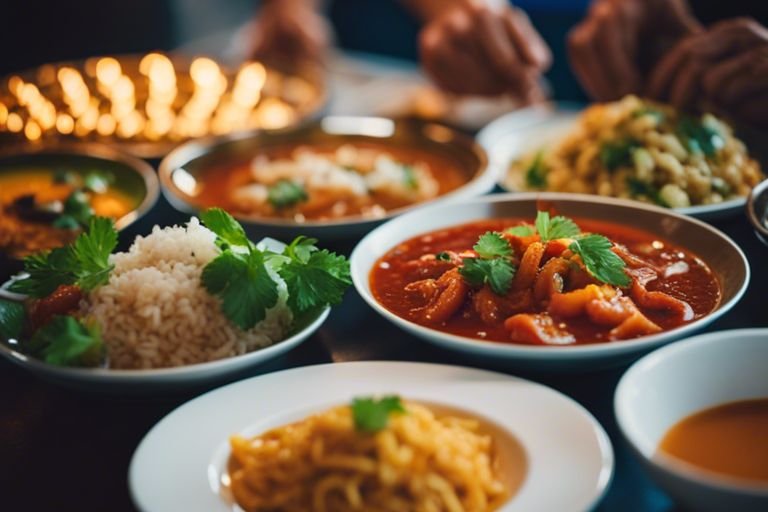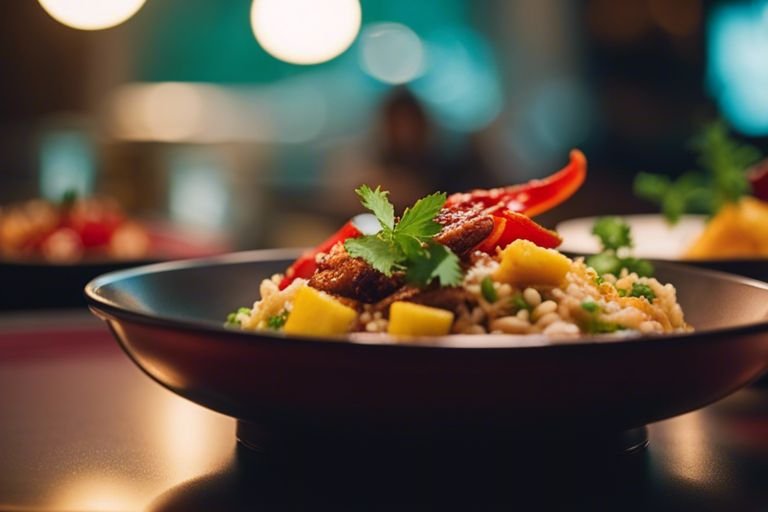Recipes. Culinary adventures await as we look into the world of Third Culture Cuisine, blending flavors and techniques from different cultures to create mouthwatering fusion dishes. From Korean tacos to sushi burritos, these unique recipes offer a tantalizing twist on traditional dishes that are sure to excite your taste buds. Join me on a culinary journey as we explore these innovative and delicious creations that showcase the beauty of cultural diversity on a plate.

Key Takeaways:
- Blend of Cultures: Third Culture Cuisine combines flavors and techniques from different culinary traditions, resulting in unique and exciting fusion dishes.
- Unexpected Combinations: Get ready to experience a culinary adventure with recipes that mix ingredients in innovative and unexpected ways, creating delicious and memorable dishes.
- Creative Cooking: Embrace experimentation in the kitchen and challenge traditional cooking boundaries by trying out these fusion recipes that bring together the best of multiple culinary worlds.
Defining Third Culture Cuisine
While the concept of fusion cuisine is not new, third culture cuisine takes this idea to a whole new level. It represents a melting pot of flavors, techniques, and ingredients from multiple cultures, creating unique and exciting culinary experiences. Third culture cuisine is often a reflection of individuals who have lived in or been influenced by more than one culture, resulting in a diverse and innovative approach to food.
The Concept of Cultural Fusion
One of the key aspects of third culture cuisine is the blending of traditional cooking styles and ingredients from different parts of the world. This fusion can lead to the creation of dishes that are both comforting and adventurous, familiar yet novel. Chefs and home cooks alike are constantly experimenting with new combinations, drawing inspiration from their own backgrounds and the global food scene to push the boundaries of culinary creativity.
Historical Roots of Third Culture Cuisine
Cultural exchange through trade, colonization, and immigration has played a significant role in shaping the development of third culture cuisine. As people traveled and settled in new lands, they brought their culinary traditions with them, which inevitably interacted and merged with local food practices. This cross-pollination of flavors and techniques over centuries has given rise to the diverse and dynamic culinary landscape we see today.
Historically, regions that served as major trading hubs or colonial outposts often became hotbeds for culinary fusion. For example, the spice trade routes in Asia led to the blending of Indian, Chinese, Malay, and European cuisines, resulting in dishes like Nasi Goreng and Chicken Tikka Masala that are now enjoyed worldwide.

Fusion Feasts from Around the World
Korean-Mexican BBQ Tacos
Fusion cuisine takes on a whole new level with Korean-Mexican BBQ Tacos. This innovative creation combines the bold flavors of Korean barbecue with the beloved Mexican street food, tacos. Imagine tender marinated bulgogi beef topped with spicy kimchi, fresh cilantro, and a drizzle of creamy sriracha mayo, all nestled in a warm tortilla. Each bite is a harmonious blend of sweet, savory, and spicy flavors that will tantalize your taste buds.
Indian-Italian Chicken Tikka Lasagna
The fusion of Indian and Italian cuisines results in a mouthwatering dish known as Chicken Tikka Lasagna. The rich and creamy layers of lasagna noodles are interspersed with succulent pieces of tandoori chicken, aromatic tikka masala sauce, and gooey mozzarella cheese. This unique fusion dish offers a tantalizing mix of spices and textures, creating a culinary experience that is truly unforgettable.
Tikka masala, a classic Indian dish, is reimagined in this fusion recipe by incorporating it into the beloved Italian comfort food, lasagna. The result is a dish that pays homage to both culinary traditions while offering a unique twist that will impress even the most discerning food enthusiasts.
Japanese-Peruvian Ceviche
IndianItalian cuisine comes together in a surprising yet delightful way with Japanese-Peruvian Ceviche. This fusion dish combines the freshness of Japanese sashimi with the bold flavors of Peruvian ceviche. Imagine tender pieces of fresh raw fish marinated in citrusy yuzu and spicy aji Amarillo, garnished with crisp seaweed and crunchy corn nuts. Each bite offers a symphony of flavors and textures that will transport your taste buds to culinary bliss.
To experience the exciting world of third culture cuisine, be sure to try these unique fusion recipes that offer a fresh twist on traditional dishes from around the globe. Get ready to commence on a culinary journey unlike any other, where diverse flavors come together to create unforgettable dining experiences.
The Art of Fusion Cooking
Not just a mere blending of culinary traditions, fusion cooking is a delicate art that requires a deep understanding of flavors and techniques from different cultures. When done right, it can create wonderfully harmonious dishes that tantalize the taste buds and leave a lasting impression.
Balancing Flavors and Textures
For a successful fusion dish, it’s important to strike the perfect balance of flavors and textures. Whether it’s the sweet and spicy combination of Thai and Mexican cuisine or the creamy and crunchy elements of French and Japanese cooking, each component should complement and elevate the other to create a truly unique dining experience.
Experimenting with Unconventional Ingredients
The key to successful fusion cooking lies in creativity and innovation. By incorporating unconventional ingredients from different culinary traditions, you can push the boundaries of flavor profiles and create dishes that are truly one-of-a-kind. Whether it’s using miso in Italian pasta or kimchi in tacos, don’t be afraid to think outside the box and experiment with unexpected flavor pairings.
The art of fusion cooking is all about pushing the boundaries and challenging traditional culinary norms. By combining elements from different cultures in unexpected ways, you can create dishes that are exciting, bold, and full of personality.
Tips for Successful Fusion Recipes
To ensure your fusion recipes are a hit, start by familiarizing yourself with the flavor profiles and cooking techniques of the cuisines you’re combining. This will help you create harmonious dishes that pay homage to each tradition while also forging new culinary paths.
- Experiment with different spice blends and seasoning combinations to find the perfect balance of flavors.
- Don’t be afraid to mix and match ingredients from different cuisines to create unique and delicious dishes.
Textures are just as important as flavors in fusion cooking. Combining crispy, crunchy, and creamy elements can create a delightful dining experience that keeps your taste buds intrigued with every bite. Assume that every ingredient you add should contribute not only to the taste but also to the overall mouthfeel of the dish.
The key to successful fusion cooking lies in experimentation and a willingness to think outside the box. By embracing the diversity of culinary traditions and being open to new flavor combinations, you can create dishes that are truly extraordinary. Assume that with a bit of creativity and a lot of passion, the possibilities are endless in the world of fusion cuisine.
Third Culture Cuisine in Modern Restaurants
Chef Interviews: Inspirations and Challenges
For all the curious food enthusiasts out there, delving into the world of third culture cuisine in modern restaurants means getting insights from the chefs themselves. These culinary artists are inspired by a myriad of cultural influences that shape their unique fusion creations. From blending traditional recipes with modern techniques to experimenting with unexpected flavor combinations, chefs navigating third culture cuisine encounter both inspiration and challenges.
Restaurant Reviews: Standout Fusion Menus
For any food lover looking to initiate on a gastronomic adventure, exploring standout fusion menus in modern restaurants is a must. These establishments push the boundaries of traditional cuisine by seamlessly merging flavors, techniques, and ingredients from diverse cultures. Dishes like Korean tacos, sushi burritos, and Indian pizza are just a glimpse into the innovative world of third culture cuisine.
The fusion menus in these restaurants not only tantalize the taste buds but also offer a glimpse into the creativity and skill of the chefs behind the dishes. Each bite tells a story of cultural exchange and culinary craftsmanship that is sure to leave a lasting impression on diners.
The Rise of Third Culture Cuisine in Food Trends
The blending of diverse culinary traditions to create third culture cuisine has been steadily gaining popularity in recent years. Food enthusiasts are increasingly seeking out unique dining experiences that offer a fusion of flavors from around the world. This culinary movement not only celebrates diversity but also highlights the interconnectedness of global food cultures.
Inspirations in this realm come from a variety of sources, such as travel experiences, family heritage, and culinary training. Chefs who embrace third culture cuisine are inspired to innovate and create dishes that reflect their personal stories and the multicultural world we live in.
Restaurants at the forefront of this trend are embracing the concept of third culture cuisine wholeheartedly, creating menus that showcase the beauty of cultural fusion. By blending techniques, ingredients, and traditions from diverse backgrounds, these establishments are leading the way in shaping the future of the culinary landscape.
DIY Fusion Recipes to Try at Home
Simple Korean-Style BBQ Beef Tacos
Beef is a staple in Korean cuisine, known for its flavorful and tender quality. To create a fusion dish, try making Korean-style BBQ beef tacos. Marinate thinly sliced beef in a mixture of soy sauce, sesame oil, garlic, ginger, and brown sugar for a few hours. Then, grill the beef to create that smoky BBQ flavor.
Fill warm tortillas with the grilled beef, top with a spicy kimchi slaw, and drizzle with a creamy gochujang sauce for a perfect blend of Korean and Mexican flavors. These tacos will surely be a hit at your next dinner party!
Indian-Spiced Apple Pie
Beef swap the traditional cinnamon in apple pie for a mix of Indian spices like cardamom, cloves, and nutmeg to give your dessert a spicy twist. The warm and aromatic flavors will complement the sweetness of the apples beautifully, creating a unique and delicious dessert.
Plus, serving this Indian-spiced apple pie with a dollop of cardamom-infused whipped cream will elevate the flavors even more, making it a perfect ending to any meal.
Japanese-Style Ramen Burgers
Ramen Swap the traditional burger bun for crispy ramen noodles to create a Japanese-inspired ramen burger. Cook the ramen noodles until crispy and use them as the “buns” for your burger. Sandwich a juicy beef patty, sautéed shiitake mushrooms, and a runny fried egg between the ramen buns for a mouthwatering fusion creation.
This inventive dish combines the comforting flavors of a burger with the umami-rich taste of ramen noodles, creating a truly unforgettable dining experience that will impress your guests.
The Cultural Significance of Third Culture Cuisine
Now, Third-Culture Cuisine: A Culinary Revolution is reshaping the way we perceive food and culture. This innovative culinary movement blends flavors, techniques, and traditions from various cultures, resulting in unique fusion dishes that captivate the senses and tell stories of migration, globalization, and adaptation.
Preserving Cultural Heritage through Food
Any culture’s food is more than just sustenance; it’s a representation of history, traditions, and values passed down through generations. Third culture cuisine plays a vital role in preserving these rich cultural heritages by incorporating diverse elements into dishes while paying homage to their origins. Through the fusion of ingredients and cooking methods, chefs can create innovative recipes that celebrate the cultural tapestry of our world.
Breaking Down Culinary Borders
Food has the remarkable ability to transcend geographical boundaries and bring people together through shared culinary experiences. In a world that is increasingly interconnected, third culture cuisine bridges the divide between different communities by offering a common ground where diverse culinary traditions converge. This blending of flavors and techniques not only results in delicious dishes but also fosters understanding and appreciation for the cultural diversity that enriches our global society.
Through the fusion of ingredients, culinary techniques, and cultural influences, third culture cuisine has the power to break down barriers and build connections between people from all walks of life. Whether through sharing a meal with strangers or collaborating with chefs from different backgrounds, food has the unique ability to create a sense of unity and belonging. Breaking bread together is not just a communal act but a testament to the shared human experience that transcends borders and fosters connections that can last a lifetime.
Final Words
The exploration of Third Culture Cuisine opens up a world of unique fusion recipes that blend different culinary traditions in creative and delicious ways. While some might be hesitant to step outside their culinary comfort zones, trying these fusion recipes provides an opportunity to experience new flavors and expand one’s palate. The beauty of fusion cuisine lies in its ability to bring people together through a shared love of food, regardless of cultural background.
The culinary world is ever-evolving, and discovering new fusion recipes is a thrilling journey that challenges our preconceived notions of traditional dishes. So, next time you’re in the kitchen, don’t be afraid to mix and match ingredients from different cultures to create your own delicious fusion creations. Who knows, you might just stumble upon the next big culinary sensation!
FAQ
Q: What is Third Culture Cuisine?
A: Third Culture Cuisine is a unique fusion of flavors and cooking techniques that result from the blending of at least three different cultural influences in a dish. It showcases the creativity and diversity of culinary traditions around the world.
Q: Why should I explore Third Culture Cuisine?
A: Exploring Third Culture Cuisine allows you to experience new and exciting flavor combinations that you may not have encountered before. It expands your culinary horizons and introduces you to the diverse cultural heritage of different regions.
Q: Can you share some unique fusion recipes I should try?
A: Sure! Some popular Third Culture Cuisine recipes include Korean BBQ tacos, sushi burritos, and pineapple curry pizza. These dishes combine elements from different culinary traditions to create delicious and innovative flavor profiles that are sure to impress your taste buds.
